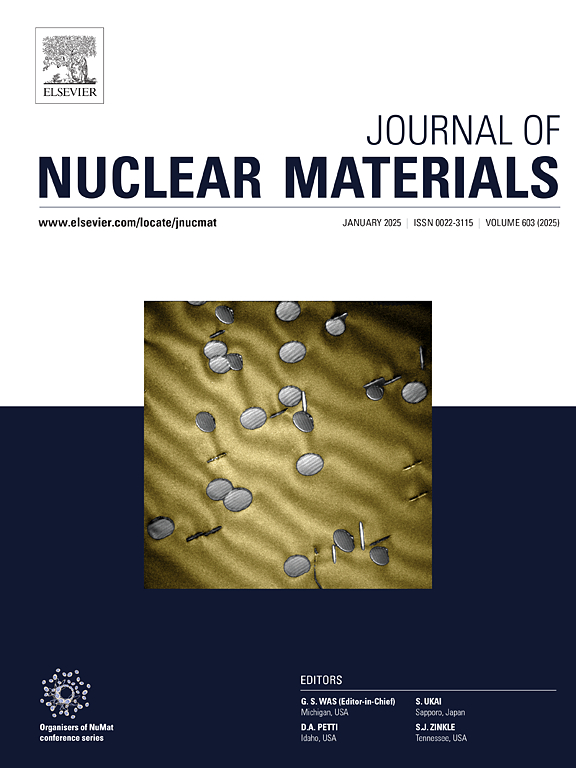Effect of oxidation temperature on microstructure and liquid lead-bismuth eutectic corrosion resistance of pre-oxidized film on high-silicon ferritic/martensitic steel
IF 3.2
2区 工程技术
Q3 MATERIALS SCIENCE, MULTIDISCIPLINARY
引用次数: 0
Abstract
This study systematically investigates the influence of oxidation temperature on the microstructural of pre-oxidized films and their corrosion resistance in liquid lead-bismuth eutectic (LBE) for ferritic/martensitic steel. Key findings demonstrate that pre-oxidation temperature significantly affect oxide film composition: (Cr,Fe)₂O₃ oxides initiate formation above 650 °C, while MnCr₂O₄ spinel phases emerge at temperatures exceeding 720 °C. In addition, a progressive increase in pre-oxidation temperature from 650 °C to 780 °C results in oxide film thickening from ∼50 nm to ∼250 nm. Corrosion tests in static oxygen-saturated LBE at 550 °C reveal that higher pre-oxidation temperatures enhance the LBE corrosion resistance of the pre-oxidized films due to increased thickness and improved oxide composition. The best protective effect is achieved after pre-oxidation at 780 °C. However, microstructural defects such as oxide interfaces and gaps between the oxide film and the substrate can serve as pathways for inward oxygen diffusion and outward iron diffusion. Over time, ions preferentially penetrate the pre-oxidized film along defect-rich regions, leading to the formation of localized corrosion zones. This research elucidates the influence mechanism of oxidation temperature on the microstructure and LBE corrosion resistance of pre-oxidized films, providing guidance for optimizing pre-oxidation processes and enhancing corrosion resistance.
氧化温度对高硅铁素体/马氏体钢预氧化膜组织及抗铅铋液共晶腐蚀性能的影响
本文系统地研究了氧化温度对铁素体/马氏体钢液态铅铋共晶预氧化膜组织及其耐蚀性的影响。关键发现表明预氧化温度显著影响氧化膜组成:(Cr,Fe)₂O₃氧化物在650°C以上形成,而MnCr₂O₄尖晶石相在720°C以上形成。此外,预氧化温度从650°C逐渐升高到780°C,导致氧化膜从~ 50 nm增厚到~ 250 nm。在550°C的静态氧饱和LBE中进行腐蚀试验表明,由于增加了厚度和改善了氧化物成分,较高的预氧化温度增强了预氧化膜的抗LBE腐蚀能力。在780℃预氧化后达到最佳保护效果。然而,氧化界面和氧化膜与衬底之间的间隙等微观结构缺陷可以作为向内氧扩散和向外铁扩散的途径。随着时间的推移,离子优先沿着富含缺陷的区域穿透预氧化膜,导致局部腐蚀区域的形成。本研究阐明了氧化温度对预氧化膜微观结构和抗LBE腐蚀性能的影响机理,为优化预氧化工艺、提高抗腐蚀性能提供指导。
本文章由计算机程序翻译,如有差异,请以英文原文为准。
求助全文
约1分钟内获得全文
求助全文
来源期刊

Journal of Nuclear Materials
工程技术-材料科学:综合
CiteScore
5.70
自引率
25.80%
发文量
601
审稿时长
63 days
期刊介绍:
The Journal of Nuclear Materials publishes high quality papers in materials research for nuclear applications, primarily fission reactors, fusion reactors, and similar environments including radiation areas of charged particle accelerators. Both original research and critical review papers covering experimental, theoretical, and computational aspects of either fundamental or applied nature are welcome.
The breadth of the field is such that a wide range of processes and properties in the field of materials science and engineering is of interest to the readership, spanning atom-scale processes, microstructures, thermodynamics, mechanical properties, physical properties, and corrosion, for example.
Topics covered by JNM
Fission reactor materials, including fuels, cladding, core structures, pressure vessels, coolant interactions with materials, moderator and control components, fission product behavior.
Materials aspects of the entire fuel cycle.
Materials aspects of the actinides and their compounds.
Performance of nuclear waste materials; materials aspects of the immobilization of wastes.
Fusion reactor materials, including first walls, blankets, insulators and magnets.
Neutron and charged particle radiation effects in materials, including defects, transmutations, microstructures, phase changes and macroscopic properties.
Interaction of plasmas, ion beams, electron beams and electromagnetic radiation with materials relevant to nuclear systems.
 求助内容:
求助内容: 应助结果提醒方式:
应助结果提醒方式:


